Class 04.12.14
Topic: The influence of environmental conditions on seed germination. Growth and development of plants. Seasonal phenomena in plant life
Target: consider how external conditions—light, temperature, pressure, humidity—affect seed germination. List the phenomena that occur in the life of plants with the onset of different seasons. Foster respect for nature
Lesson progress
Learning new material
Seed germination. The seeds of most plants have a dormant period - they do not germinate for some time even under favorable conditions. For seed germination, a set of certain conditions are needed, different for each type of plant: sufficient humidity, the presence of air, a certain temperature, and for some (lettuce, phacelia) even light. Under favorable conditions, the seed absorbs water and swells. At the same time, her breathing intensifies, reserve nutrients are transferred into a form available for consumption by the embryo (sugary substances are formed). First the root sprouts, then the bud. The root breaks through the skin of the seeds and grows deep into the soil, as it reacts to the force of gravity of the Earth, the shoot is directed upward, towards the surface of the soil. From the moment of germination, a plant is called a seedling. There are two types of seed germination: aboveground, when the cotyledons are brought to the soil surface during germination (beans, pumpkin), and underground, when the cotyledons remain in the soil (peas, wheat). Many types of seed germination combine features of both types. An important characteristic is seed germination - its ability to germinate. All these features must be taken into account when sowing seeds of various crops.
Height- one of the manifestations of the individual development of organisms is associated with an increase in their live weight. Growth is caused by cell division, an increase in their size and the mass of intercellular substance. Development is the qualitative changes that occur in the body from the moment of birth and determine its formation. A distinction is made between individual development of an organism (from birth to death) and historical (development of organisms, their systematic categories, as well as the organic world as a whole).
Growth and development of plants. Plants, like all living organisms, are capable of growing and developing. The peculiarity of plants is that growth continues throughout their life. Growth is an increase in size, volume and mass of the entire organism and its individual parts. Plant growth can be continuous or periodic. In many plants, periodicity is associated with a shortening of the duration of the daylight hours and the onset of winter - at this time growth is inhibited. The relationship between day and night is called photoperiodism. The rate and duration of growth are regulated by phytohormones.
The development of plants is closely related to their growth, but these concepts are different. Development is the qualitative changes that consistently occur in the body and in its individual parts throughout life. For example, the appearance of a flower is a new qualitative state of the entire plant organism. The totality of all phases of development of an organism is called the life cycle. Individual development of plants occurs in several successive stages. In the life cycle of flowering plants, embryonic and postembryonic periods are distinguished. Postembryonic includes the stages of germination, youth, maturity and senescence.
Seasonal phenomena in plant life
Phenology e that is the science of seasonal phenomena in nature. She records and studies periodic phenomena in living and lifeless nature that are associated with changes in the seasons. As usual, there are four seasons: spring, summer, autumn and winter. Depending on the season, trees, bushes and grasses change in appearance, growth and development processes
Seasonal changes in plant life in spring
In spring, an increase in day length for plants is a signal for leaves to open, flowering and fruiting. Changes in the duration of the photoperiod are perceived by the leaves. They produce substances that predetermine the development of flower buds.
Spring is divided into three periods:
1 - Early spring - the appearance of thawed patches, the disappearance of snow in the fields, the flowering of early flowering primrose plants, the beginning of sapling;
2 - Middle spring (blooming) - lasts until the bird cherry blossoms;
3 - Late spring - lilacs are fading, rye is beginning to sprout, apple trees are blooming
Seasonal changes in plant life in summer
The astronomical beginning of summer is June 21-22 - the day of the elderly solstice. The presence of a large amount of heat, moisture, and light contributes to the active development of plants. Most trees that produce seeds store organic matter. A large number of bushes and tree flowers.
Summer is divided into three periods
1st - beginning of summer - flowering herbs (cornflowers, bells, daisies, etc.) appear on the bows, raspberries bloom in the forests, jugs - in ponds, garden jasmine - in gardens. In the popular calendar, June is called multicolor. Strawberries begin to ripen, summer mushrooms appear
2nd - mid-summer - begins with the flowering of the linden tree and usually lasts until mid-August. The fruits of cherries, blueberries, raspberries, currants, gooseberries, bird cherry, etc. ripen. The harvesting of winter crops is ending in the fields.
3rd - end of summer - lasts from mid-August to mid-September, to the first frosts. This is the time of mushrooms, which occurs at the end of summer and beginning of autumn. Nuts ripen in the forest, linden leaves begin to turn yellow and birch leaves begin to fall
Seasonal changes in plant life in autumn
Autumn is the time for harvesting. In autumn, most plants, including perennials, ripen fruits and seeds. The foliage of many trees and bushes changes color and then falls off: November arrives
Autumn is divided into two periods:
The first period - from the first frosts on the soil to the end of leaf fall - is golden autumn, when the colors of the leaves change and November begins. November saves the plant from drying out, from breaking branches, and substances unnecessary to the plant are removed through the leaves. In the first half of October, bird cherry and elm completely lose their leaves, then linden, maple, ash, hazel, and aspen. In the second half of October - rowan, viburnum, alder, elderberry, willow. It is important to know the sequence of ripening of seeds of tree and shrub plants in order to help schoolchildren in organizing their collection
The second period - from the end of leaf fall to the freezing of water bodies - a characteristic transition from autumn to winter
In autumn, you can observe some interesting phenomena, such as the re-blooming of plants. You can see blooming white acacia, viburnum, passerine, flowers on apple trees and pears. Herbaceous plants bloom: chamomile, clover, cornflower, dandelion... Repeated flowering is associated with the onset of warm autumn, when dormant buds begin to grow and a new development cycle begins. Using this phenomenon, breeders have developed new varieties of different plants: strawberries, roses, which bloom and bear fruit all summer long
Seasonal changes in plant life in winter
The astronomical beginning of winter is December 21-22 - the winter solstice. At this time, the northern hemisphere receives the least amount of sunlight. Plants are in deep dormancy in winter. Snow, as a poor conductor of heat, protects plants from hypothermia. One-year-old plants die leaving seeds that can withstand ultra-low temperatures (-270 °C). In perennial plants, the above-ground part dies, but the underground part remains (roots, tubers, bulbs). The trunk and branches of trees are covered with bark, in which a special pick tissue is deposited throughout life, which soaks and fills with air and protects the trunk from hypothermia
Winter is divided into three periods:
The first period (snowless) - the beginning of winter - begins from the moment of final freezing of reservoirs to the establishment of permanent snow cover
The second period (true winter) lasts until the snow begins to melt in the sun
The third period (pre-spring) lasts until the first warm days appear.
Knowledge of seasonal phenomena is of great importance for agriculture, ecology, and medicine. With the help of phenological observations, an understanding of the relationships in nature, an idea of the flexibility and integrity of nature is formed.
Reinforcing the material learned
Filling out the table
d/z study paragraph 33.34, write down the main concepts from the lesson
Class 05.12.14
Topic: Test No. 1
Trees seem completely lifeless to us in winter. And yet, even in winter, in the bitterest frosts, life does not completely leave the plants. At this time they only rest, accumulate strength, so that with the onset of spring they can throw off the shackles of winter. “What we call the dream of nature,” wrote S. Pokrovsky, “is only a special form of life, full of deep meaning and significance.” This form of life of plant organisms is called a state of rest.
In a state of deep dormancy in the winter season, the metabolism of trees and shrubs is sharply inhibited and visible growth stops. However, this does not mean that all life processes in it have completely stopped. Some of them also go during winter dormancy. For example, starch is converted into sugars and fats, sugars are consumed during respiration (although its intensity is 200-400 times less than in summer. Growth processes also occur at this time, but they do not manifest themselves externally. The resting state is a period of especially intense the activity of the so-called educational tissue, or meristem, from which new cells and tissues arise.
You can quickly restore an outdated grape bush using the layering method (“katavlak”). For this purpose, healthy vines of a neighboring bush are placed in grooves dug to the place where the dead bush used to grow, and covered with earth. The top is brought to the surface, from which a new bush then grows. Lignified vines are laid on layering in the spring, and green ones - in July. They are not separated from the mother bush for two to three years. A frozen or very old bush can be restored by short pruning to healthy above-ground parts or by pruning to the “black head” of an underground trunk. In the latter case, the underground trunk is freed from the ground and completely cut down. Not far from the surface, new shoots grow from dormant buds, due to which a new bush is formed. Neglected and severely frost-damaged grape bushes are restored due to stronger fatty shoots formed in the lower part of the old wood and the removal of weakened sleeves. But before removing the sleeve, a replacement is formed. Grape care
A gardener starting to grow grapes needs to thoroughly study the structure of the grapevine and the biology of this interesting plant. Grapes are vine (climbing) plants and require support. But it can spread along the ground and take root, as is observed with Amur grapes in a wild state. The roots and aboveground part of the stem grow quickly, branch strongly and reach large sizes. Under natural conditions, without human intervention, a branched grape bush grows with many vines of different orders, which begins to bear fruit late and produces crops irregularly. In cultivation, grapes are shaped and the bushes are given a shape that is easy to care for, ensuring a high yield of high-quality bunches. Grapevine Planting Schisandra
Schisandra chinensis, or schisandra, has several names - lemon tree, red grapes, gomisha (Japanese), cochinta, kozyanta (Nanai), kolchita (Ulch), usimtya (Udege), uchampu (Oroch). In terms of structure, systemic relationship, center of origin and distribution, Schisandra chinensis has nothing in common with the real citrus plant lemon, but all its organs (roots, shoots, leaves, flowers, berries) exude the aroma of lemon, hence the name Schisandra. The schisandra vine that clings or wraps around a support, along with Amur grapes and three types of actinidia, is an original plant of the Far Eastern taiga. Its fruits, like real lemons, are too sour to be consumed fresh, but they have medicinal properties and a pleasant aroma, and this has attracted a lot of attention to it. The taste of Schisandra chinensis berries improves somewhat after frost. Local hunters who consume such fruits claim that they relieve fatigue, invigorate the body and improve vision. The consolidated Chinese pharmacopoeia, compiled back in 1596, states: “the fruit of Chinese lemongrass has five tastes, classified as the first category of medicinal substances. The pulp of lemongrass is sour and sweet, the seeds are bitter and astringent, and in general the taste of the fruit is salty. Thus, All five tastes are present in it." Grow lemongrass
In nature, certain phenomena are repeated with an invariable sequence, from year to year. In spring, the days become warm and sunny, the snow melts, the trees become covered with leaves, and the birds arrive. In summer, the vegetation blooms luxuriantly, fruits and seeds ripen, and chicks grow in bird nests. In autumn, the sun warms less, the vegetation freezes. Then the rivers and lakes freeze, the earth is covered with white, fluffy snow - winter comes. These seasonal phenomena are studied by the science of phenology.
Long-term observations have established that seasonal natural phenomena in each area are replaced in a constant order. For example, blue flies appear in Leningrad and its environs around March 14, rooks arrive on March 16, starlings arrive on March 25, the first song of the lark can be heard on April 2, coltsfoot blooms on April 3, gray alder on April 15, April 20 - white anemone, May 10 - cress, dandelion, etc.
In years with a normal course of seasonal phenomena, the intervals between their onset are also constant: for example, in the Moscow region, about 44 days pass between the flowering of rye and its ripening; in the Kursk region, the interval between the flowering of coltsfoot and the ripening of rye ranges from 98 to 101 days. After the start of sap flow (in the Moscow area around April 2), birch blooms after 29 days, bird cherry after 38 days, lilac after 47 days, etc. Knowing the timing of the onset of seasonal phenomena and the intervals between them, you can confidently plan the start of agricultural work .
The main reason for seasonal changes in nature is solar heat. Its amount varies at different times of the year and depends on geographic latitude and altitude. Seasonal phenomena are also influenced to a certain extent by the amount of moisture in the air and soil and the duration of illumination.
SPRING
The beginning of spring is defined in different ways. Meteorologists consider March 1 to be the beginning of spring and allocate three months to each season. Astronomers consider the beginning of spring from the vernal equinox - March 21. But in nature, the arrival of spring often does not coincide with these dates. In the south it is significantly ahead of them, in the north it lags behind. And in the same area, spring begins at different times in different years. Therefore, phenology coincides the onset of spring with seasonal phenomena in nature. In the plant world, the beginning of spring is considered to be the beginning of sap flow in the Norway maple (in Leningrad around April 2, in Moscow - March 21, and in the south of the USSR - in February). Maple sap flow occurs when the ground is still covered with snow. After 10 days, sap flow begins in the birch tree, which lasts about 20 days.
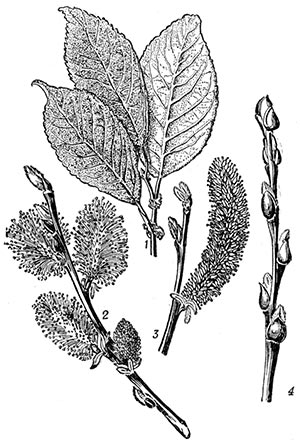
At the end of winter, the cones of spruce, pine, and alder, heated by the sun's rays, open and seeds spill out of them. Spruce and pine have winged seeds, and the wind carries them over long distances. Alder seeds are carried by meltwater, get stuck on the banks of rivers and streams and germinate there.
In the forest, the soil freezes less than in open areas and thaws in early spring. Tree roots absorb water. It rises through the woody vessels, dissolves the reserves of organic substances deposited over the past summer in the roots and wood, and carries them to the buds.
In the spring, in the forest soil, still under the snow, at temperatures close to zero, plants begin to awaken. For example, oak anemone, chistyak, scilla, lungwort and other plants are starting to grow. The coltsfoot, anemone, and lungwort sprout wintering rhizomes, the goose onion and tulip - bulbs, and the chrysalis and corydalis - nodules. In the rhizomes, bulbs and nodules, reserves of nutrients are deposited, which allow these plants, as soon as the snow melts, to quickly grow and bloom even before the flowering of meadow plants.
At the edge of the forest at this time you can find seedlings of maple, birch, and alder. Their seeds, scattered in the fall (maple) or early spring (alder), swell and begin to germinate when the snow melts.
With the first rays of spring, willow buds shed their dark-colored caps. White fluffy hairs covering the buds protect them from sudden temperature fluctuations. Male alder catkins become loose and crack. In the Leningrad region they open their anthers around April 15th. At the same time, small reddish female flowers bloom at the ends of the alder branches next to the male inflorescences. The wind picks up pollen from the catkins and carries it to other trees.
Soon after the alder, the hazel-hazel blooms (in the Leningrad region - approximately April 20). In winter, its female flowers are hidden in the buds, and during the flowering period, purple feathery stigmas appear from the moving scales.
Both alder and hazel are wind-pollinated plants. They grow in groups. Before the leaves appear, the wind passes freely through the tree crowns and, in dry weather, transfers pollen from one tree to another. In damp weather, the anthers close and pollen does not fall out.
Behind the hazel, other trees are blooming: red willow, aspen, goat willow, silver poplar, warty birch (in the Leningrad region - by May 10).
Willow is pollinated by insects. Its male flowers are collected in bright yellow inflorescences, clearly visible against the background of the still transparent forest. Female flowers are paler in color. Both of them emit a pleasant smell and secrete nectar, which attracts a lot of insects. There are still few other flowering plants, and insects visit the willow in search of food. During the period between the flowering of hazel and warty birch, the leaves of red elderberry, black currant, and bird cherry bloom. The larch also begins to turn green.
The coloring of the deciduous forest gradually fades. is changing. In winter, the tree crowns are dark in color. With the beginning of sap flow, the bud scales begin to gradually move apart, their reddish internal parts protrude, and the crowns of the trees noticeably turn pink. Then green leaves appear, which leads at first to a barely noticeable, and then every day to a stronger change in the color of the forest - the forest begins to turn green.
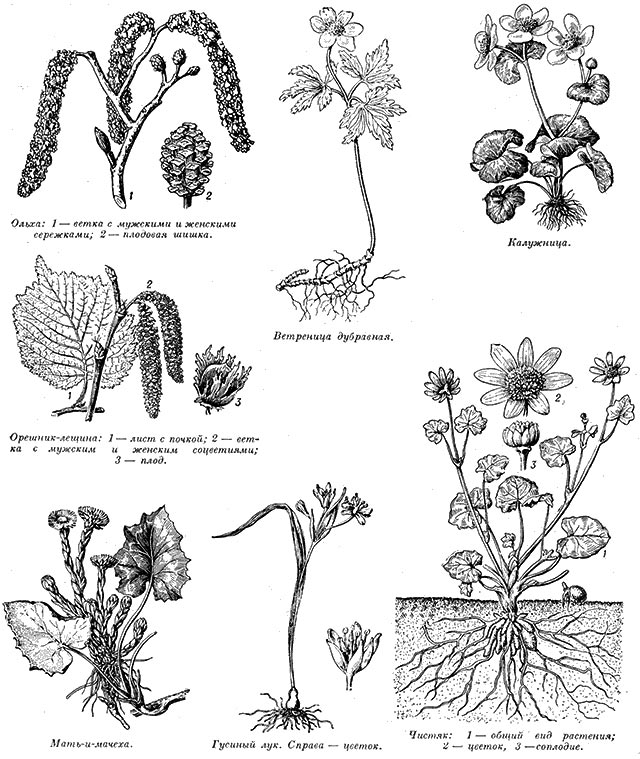
Coltsfoot is one of the first herbaceous plants to bloom. It grows on the slopes of railroad tracks, in vacant lots, and on clay cliffs. On the southern slopes it blooms when there is still snow all around, and its yellow heads stand out brightly against the background of last year's brown grass. At this time, small yellowish-green scale-like leaves appear on the coltsfoot, and the true leaves with a dark green upper surface and a whitish lower surface covered with hairs bloom later, when the flying fruits already turn white on the elongated flowering stems.
The name “coltsfoot” comes from the fact that the properties of the lower and upper surfaces of its leaves are different; If you apply a leaf to the cheek with the lower, hair-covered surface, it warms, “like a mother,” and the upper surface is cold, “like a stepmother.”
Following the coltsfoot, the noble coppice blooms, and then the oak anemone, lungwort, goose onion, marigold in damp meadows, and chistak. Behind it, the corydalis and spleen bloom, the greenish-yellow colored leaves of which form bright spots on the spring cover of the forest soil.
All these plants usually grow in groups. They reproduce by vegetative organs - rhizomes, nodules, bulbs, but can also reproduce by seeds. In the spring, insects fly into the still bare forest and promote cross-pollination of forest plants.
The last period of spring begins with the flowering of yellow acacia (in Leningrad - by May 25, in Moscow - by May 20). During this period, most tree and shrub species bloom. It ends in the first half of June,
SUMMER
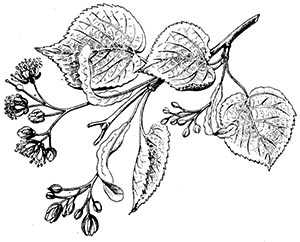
According to the calendar, summer begins on June 1. Astronomical summer begins with the summer solstice (June 22), and in phenology the beginning of summer is usually considered to be the fading of the purple lilac and the beginning of the dispersal of elm fruits.
From this time on, herbaceous vegetation develops luxuriantly: many meadow and field plants bloom (spreading bellflower, red clover, cornflower, fireweed, grasses). The first ripe strawberry fruits appear in open areas, and the seeds of fragrant poplar ripen and scatter. Meadow geranium and china are blooming, in the fields and wastelands - sow thistle, tartar, burdock, in reservoirs - chastuha and water buckwheat. Around July 15 in Leningrad and July 10 in Moscow, small-leaved linden blooms. This moment is considered in phenology to be the beginning of the second summer period. During this period, tansy, elecampane and other plants bloom, the fruits of elderberry and yellow acacia ripen, and the harvesting of winter rye begins.
The last period of summer begins with the flowering of heather and the ripening of hazel fruits (in Leningrad - around August 20). At this time, the fruits of oak, rowan and other plants ripen, harvesting of oats and sowing of winter crops begins.
Over the summer, herbaceous and woody plants have time to grow significantly. As an example of the greatest growth, we can cite Sakhalin buckwheat, which grows up to 4-5 m, corn and hemp, which grow up to 3.5 m. The shoots of many young trees reach a meter, and aspen shoots - 3 m. At the top of each tree shoot and in the axils While the leaves are still growing, tubercles can be seen. These are the rudiments of future apical and lateral buds. Over the summer they manage to complete their formation.
In summer, mass flowering of a variety of herbaceous plants occurs; by the end of summer, the number of flowering plants decreases. A period of mass ripening of fruits and seeds begins. They have a wide variety of dispersal devices.
Many fruits and seeds are dispersed by the wind. Some plants have hairs on their seeds. The wind picks up the seeds and carries them over long distances. Such flying fruits are found in dandelion, sow thistle, tartar, valerian, fireweed, aspen, poplar, willow and other plants.
Maple, ash, elm, and birch have winged fruits. Usually the fruits of maple and ash are scattered by strong autumn winds in rainy weather. The rain nails them to the ground and partially buries them. The fruits of birch and elm, seeds of spruce and pine are carried in clear weather; they have thin membranous wings.
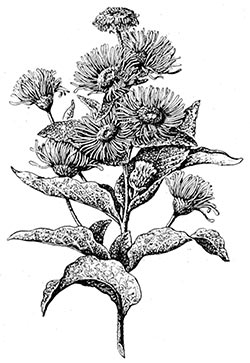
Animals and humans also contribute to the dispersal of fruits and seeds. Fruits with hooks and attachments stick to the fur of animals (chain, gravilat, cocklebur), and the entire fruit of the burdock breaks off and attaches to the fur. Animals often move over long distances, they rub against various objects, lie down on the ground, shake themselves and thus scatter seeds and fruits attached to their fur. Small dust-like seeds of some plants (cracker, monochromatic, small-petalled, poppies) are also scattered by the wind.
Juicy fruits, until the seeds are ripe, have a green color that is hardly noticeable against the general green background. But as they mature, they acquire a bright color and become clearly visible. Juicy, ripe fruits attract animals not only by color, but also by smell and taste. When eating these fruits, animals also swallow small seeds, and then throw them away intact along with droppings on the ground, where the seeds germinate.
On the migratory routes of birds, seeds of northern plants are found, carried by birds far to the south. The fruits and seeds of marsh plants are carried by birds living in the marshes. When ripe, the seeds fall into the swamp silt, stick with it to the paws of birds and are carried by them from one swamp to another.
Seeds of roadside plants stick to the hooves and paws of animals, to the wheels of carts and cars, to the tracks of tractors and are also carried over long distances.
Water is of great importance in the dispersal of fruits and seeds. The seeds of aquatic and coastal plants (sedge, willow, alder) are dispersed by water.
But there are many plants that disperse seeds themselves. For example, when the fruits of yellow acacia, lupine, vetch and other plants dry out, their walls crack, the flaps of the walls curl and, like springs, scatter the seeds far from the plant. From the fruits of poppy, henbane, foxglove, flax and other plants, seeds are scattered when the wind blows or an animal runs past the plant. At the same time, the stems bend, and then straighten and throw the seeds out of the fruit, as if from a sling. Ripe balsam fruits, if touched, burst into slices and the seeds are scattered around with force.
AUTUMN
According to the calendar, autumn begins on September 1. Astronomers consider the day of the autumnal equinox, September 23, to be the beginning of autumn. In phenology, the beginning of autumn is considered to be the appearance of yellow leaves on birch. Yellowing of leaves
Birch trees sometimes become noticeable as early as mid-August. More often, obvious signs of autumn can be observed only after the first autumn frosts (in Leningrad - usually in early September). Following the birch, the leaves of linden and bird cherry begin to turn yellow, and the leaves of aspen and maple turn red.
Simultaneously with the change in color, the leaves begin to fall off. For most of our trees, leaf fall lasts for several weeks. Leaves fall not only because of the onset of cold weather. If, for example, a birch tree is grown at room temperature, its leaves will still fall off in the fall. Leaf fall, like a change in leaf color, is associated with a change in the vital activity of the plant organism. This is a natural link in the development of plants. By the beginning of autumn, a layer of special cells forms in the leaf petioles - the so-called separating layer. It separates the leaves from the plant, breaking their connection with the branch. At the slightest breath of wind, the leaves easily fall off the branches.
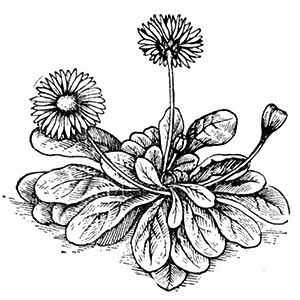
Leaf fall prepares the plant for the transition to a dormant state and helps it survive unfavorable winter conditions. After the leaves fall, the evaporation of water by the plant decreases, and the danger that snowfall will break off the branches also decreases. In addition, during the summer period, a large amount of mineral salts that the plant does not need accumulate in the leaves, and when leaves fall, it is freed from them.
In southern countries, evergreen trees also shed old leaves, freeing themselves from the mass of unnecessary substances accumulated in them. Some of them lose their leaves gradually throughout the year, and therefore these trees are always green. In others, the leaves fall off simultaneously, completely, but for a relatively short period of time.
Herbaceous vegetation also changes in early autumn. Brown tones appear in it, some of the stems and leaves dry out and turn yellow.
There are, however, also flowering plants. Some of them - dandelion, meadow clover, heartwort - are blooming for the second time. But there are plants that usually bloom in autumn: chicory, crow's feet, cornflower. Tricolor violets and daisies bloom until late autumn. Sometimes they even disappear under the snow in a blooming state. In late summer, heather, white rose, golden rod, and various wormwoods bloom. After harvesting the grain, you can find many flowering weeds in the fields.
Most annual plants die in the fall. Their seeds fall to the ground and survive the winter cold under the snow. But many annual weeds produce several generations over the summer: for example, shepherd's purse, jarutka, woodlice. Their seeds do not go through a dormant period; they germinate in the fall. Young plants do not have time to complete their development and continue to develop in the spring after the snow melts.
Biennial and perennial herbaceous plants overwinter in the form of rosettes, tightly pressed to the ground, or in the form of creeping stems, for example, primrose, dandelion, rapeseed, daisy, tricolor violet, mantle, celandine, foxglove, buttercup, dead nettle, strawberry and a number of other plants. Many of them have rhizomes, tubers and bulbs that sprout in the spring before other plants.
Algae overwinter at the bottom of reservoirs or form spores in winter and die off.
WINTER
According to the calendar, winter begins on December 1st. In astronomy - on the day of the winter solstice, December 22. And in phenology, the beginning of winter in the central zone of the Soviet Union is considered the time when water bodies freeze.
In winter, all life processes seem to completely freeze in the plant world. However, this is not entirely true. If cut branches of oak, maple, linden or other trees are placed in water in early October, immediately after leaf fall, they usually do not bloom. They are in a state of deep rest. This dormant period is characteristic of all plants, although its duration varies among different species. For example, for poplar, bird cherry and lilac, the dormant period ends by December, for oak, birch and linden it continues until January-February. The closer to the end of winter, the sooner the buds will bloom on branches placed in water. If the branches are cut in February or March and placed in water, they quickly form leaves. At this time, their peace becomes forced.
The dormant period is of great importance in the life of plants. Dormant plants do not begin to grow during occasional thaws, otherwise subsequent frosts would destroy them. When the period of deep dormancy ends, the plants also do not immediately begin to grow: the low ambient temperature leaves them in forced rest.
In winter, seeds from dried stems of various plants sticking out from under the snow spill onto the snow. They are carried by the wind over long distances. When the sun begins to warm up more strongly, the cones of spruce and pine open, the cones of alder burst and the seeds scatter. These are already signs of the end of winter. After a period of long rest, nature begins to awaken again. And spring comes again.
With the onset of winter, trees go into a dormant state. Metabolism inside the trunk is inhibited, and the visible growth of trees stops. But life processes do not stop completely. During the period of long winter dormancy, mutual transformations of substances occur, although with much less intensity than in summer (Journal “Chemistry and Life”, “Plants in Winter”, V.I. Artamonov, February 1979).
Trees grow in winter, although it is practically not visible outwardly. In cold weather, the so-called educational tissue actively develops, from which new cells and tissues of the tree subsequently arise. In deciduous trees, the formation of leaf primordia occurs in winter. Without such processes, the transition of plants to active life with the arrival of spring would be impossible. The winter dormancy phase is an indispensable condition for normal tree growth during the growing season.
The ability of trees to enter a state of dormancy developed over a long period of evolution and became the most important mechanism of adaptation to unfavorable and harsh external conditions. Similar mechanisms are involved in other difficult periods of tree life, including summer. For example, during severe drought, plants can shed their leaves and almost completely stop growing.
Features of winter dormancy in trees
The signal for the transition to a special winter state for most trees is a reduction in the length of daylight hours. Leaves and buds are responsible for the perception of such changes. When the day is noticeably shortened, a change in the ratio between substances occurs in plants that stimulate metabolic and growth processes. The tree is gradually preparing to slow down all life processes.
The trees remain in a state of forced dormancy until the end of the winter period, gradually preparing for complete awakening. If at the end of February you cut a birch branch in the forest and place it in water in a warm room, after a while the buds will begin to swell, preparing to sprout. But if a similar procedure is done at the beginning of winter, the birch tree will not bloom for a very long time, because it is already completely ready for dormancy.
The duration of the winter dormancy period varies for different types of trees and shrubs. For lilacs, this period is very short and often ends by November. In poplar or birch, the deep dormancy phase lasts much longer, until January. Maple, linden, pine and spruce are capable of being in a state of deep forced dormancy for four to six months. After wintering, trees slowly but steadily begin to restore life processes, resuming their growth.
Starting in late autumn and then throughout the winter, the tree and shrub species of the flora of our region are in a state of dormancy. Such winter phenomena in the life of plants are caused by many reasons. Among them are a significant decrease in temperature, lack of sufficient nutrition, and others. The life processes of plants are inhibited, and even under favorable conditions that arise suddenly, they cannot resume. Many people have probably noticed that if you bring home a cut branch of a tree in December-January and put it in warm water, it does not “wake up”, maintaining its lifeless appearance. But if you do this at the very end of winter, when spring is approaching, then the buds will immediately bloom, although it is still very cold outside. Why is this happening? What role does winter play in the life of plants? What makes the flora in the wild and in the surrounding squares and parks wake up, blooming with fresh foliage? We will try to answer these and other equally interesting questions in our article.
Plants in winter
In hot countries, whether winter or summer, the temperature does not “jump” much from the main average indicators. Therefore, trees in the subtropics and tropics grow and turn green all year round. Central Russia, for example, is a different matter. Or Siberia. Here, temperature fluctuations “plus or minus” sometimes amount to gaps of fifty degrees, and this is simply destructive for many species of deciduous trees. Wise nature has come up with protective reactions for these plants with foliage to poor living conditions that arise in the cold. Winter phenomena in the life of plants are a kind of “blocking” of life processes, helping to survive difficult times. What happens to them? 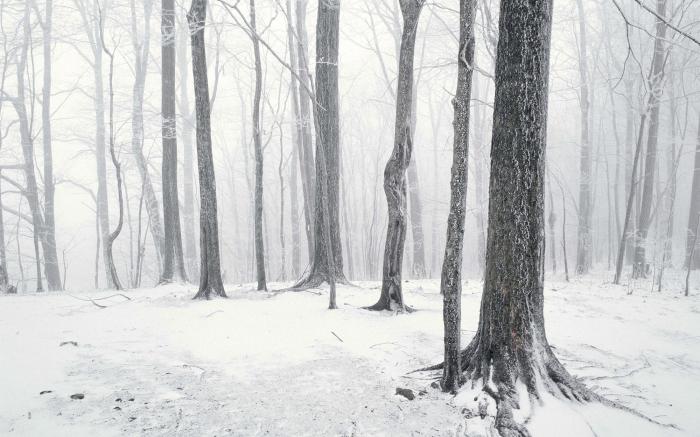
Metabolism
Winter phenomena in the life of plants cause a state of dormancy, a slowdown inside the trunk. Visible tree growth stops. As does the release of moisture into the atmosphere. Just like feeding with No, trees, of course, also grow in winter. They just do it very slowly, imperceptibly to the human eye. Moisture also circulates (a complete cessation of circulation, according to scientists, occurs at a temperature of minus 18). And in winter, a large tree still evaporates up to 250 ml of moisture into the air. But, you see, these processes occur much more slowly than in the spring and summer.
Dropping leaves
Almost all trees shed their leaves in winter (except evergreens). It gradually turns yellow throughout the fall and falls off, leaving bare branches. These winter phenomena in the life of plants are also associated with mechanisms of protection from cold: the plant loses its leaves and, as it were, closes itself from the influence of the environment. Photosynthesis, a process for leaves containing chlorophyll, stops almost completely. Nutrition becomes minimal, since the main portions are processed using foliage. And the root system, due to frost, reduces the supply of moisture and minerals from the soil. 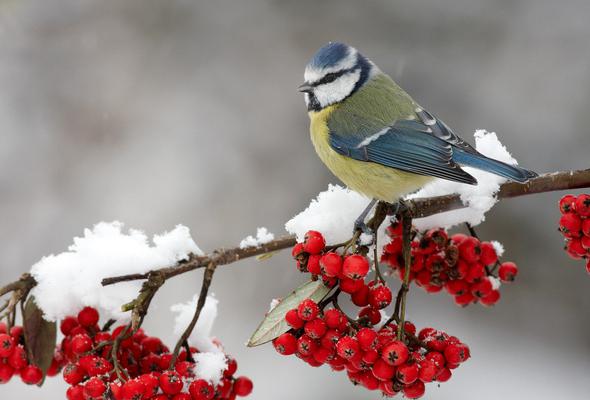
Features of the transition to hibernation
We can say that the first signal for plants is a reduction in daylight hours. When it has noticeably shortened, a change in the ratios between substances responsible for metabolism and tissue growth occurs in the cells. The tree, as it were, begins to prepare to slow down life processes.
How long does winter hibernation last for trees?
This state of deep winter dormancy, comparable to hibernation, lasts differently in different species of trees and shrubs. So, for example, for birch or poplar - until the end of January. And maple or linden remain in this state for up to six months (in especially cold winters). In lilacs, the hibernation period ends by December.



